
Expeditions
From SV Infinity's anchorage just off the south west beach of Penjalin Besar, we made one snorkeling expedition circumnavigating the island, five dives including one transect survey and two expeditions to the land.
| Penjalin (30th Nov - 2nd Dec 2006) | N | E | satellite image |
| SV Infinity's anchorage | 03° 22.1910' | 106° 25.7850' | |
| rocks with fringing reef, west side Penjalin Besar | 03° 22.8764' | 106° 25.9743' | 1 |
| bay on east side Penjalin Besar | 03° 20.5266' | 106° 26.5829' | 2 |
Penjalin Besar: beach at north end of channel |
03° 22.9654' | 106° 26.4810' | 3 |
| beginning of dive Dec 1st | 03° 22.6788' | 106° 26.6691' | 4a |
| end of dive Dec 1st | 03° 22.8456' | 106° 26.8193' | 4b |
| beginning of dive Nov 30th | 03°22.4374' | 106° 26.2588' | 5a |
| end of dive Nov 30th | 03° 22.7535' | 106° 26.6362' | 5b |
| Penjalin Besar: reef patch off SE point | 03° 22.0758' | 106° 27.0186' | 6 |
transect site |
03° 22.6027' | 106° 26.3842' | 7 |

Expeditions
From SV Infinity's anchorage just off the south west beach of Penjalin
Besar, we made one snorkeling expedition circumnavigating the island, five
dives including one transect survey and two expeditions to the land.
Island observations
Penjalin is actually two islands – Penjalin Besar (big) and Penjalin
Kecil (small) that are both uninhabited. There is a channel running between them, about
20 meters deep with a clean sand substrate. Pulau Setuju is a very aesthetic
rock just to the NE of Penjalin Besar. The channel between Penjalin Besar and
Pulau Setuju is about 1 meter deep with patchy (approximately 50%) coral coverage.
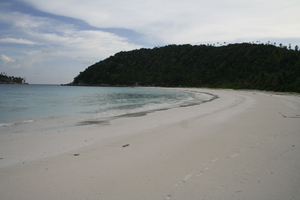 The rest of the substrate is rock. SV Infinity anchored on the SW side
of Penjalin Besar, made observational dives and snorkels on the reefs and took
expeditions to the island of Penjalin Besar (photo to the right: Penjalin
Beach). Three monkeys were sighted on the
island plus many small lizards and a domestic cat. There is good soil. On the
beach inside the channel between the two islands there is a banana plantation,
planted by the former caretakers of the land. Nobody lives there now. Several
dwarf coconut trees surround a foundation just behind the beach where there
probably used to be a small dwelling. There is also pandanus growing on the
island and mint-like shrubs. Several coconut trees have lost all their palms
and a few are showing signs of withering. There is a lot of trash on the beach;
plastic
The rest of the substrate is rock. SV Infinity anchored on the SW side
of Penjalin Besar, made observational dives and snorkels on the reefs and took
expeditions to the island of Penjalin Besar (photo to the right: Penjalin
Beach). Three monkeys were sighted on the
island plus many small lizards and a domestic cat. There is good soil. On the
beach inside the channel between the two islands there is a banana plantation,
planted by the former caretakers of the land. Nobody lives there now. Several
dwarf coconut trees surround a foundation just behind the beach where there
probably used to be a small dwelling. There is also pandanus growing on the
island and mint-like shrubs. Several coconut trees have lost all their palms
and a few are showing signs of withering. There is a lot of trash on the beach;
plastic
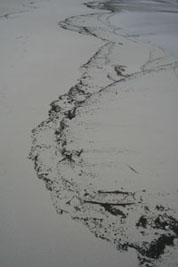 bottles,
flip-flops, ropes. There is a small shelter on the SW beach
of Penjalin Besar. Two fishermen were onshore as we dropped our anchor. The
next morning, two men were manning a fire on the island. In general, fishermen
were unperturbed by our presence and did not stop at the ship or offer to sell
us their catch. There are oil deposits washing up on this beach and some of the
boulders are caked in dried oil (see photo to the left).
bottles,
flip-flops, ropes. There is a small shelter on the SW beach
of Penjalin Besar. Two fishermen were onshore as we dropped our anchor. The
next morning, two men were manning a fire on the island. In general, fishermen
were unperturbed by our presence and did not stop at the ship or offer to sell
us their catch. There are oil deposits washing up on this beach and some of the
boulders are caked in dried oil (see photo to the left).
Beach access: On the east side of the channel on Penjalin Kecil, the bay has sandy shallows and the fine white sand beach is landable. There are some coral heads close to the shore and there are rocks just off the end of the beach. One patch on the east side comprises solely soft coral with no hard coral, about 10 meters deep. There is a distinct change here to a green color of water. On the SW side of Penjalin Besar, the beach is inaccessible due to dense coral coverage in the shallows, however, the long beach inside the channel is approachable with sandy shallows. The north side of Penjalin Besar is pretty rough right now in the NE monsoon and looks more inhospitable. There is a small beach.
Reef 1: reef fringing the east side of Penjalin
Besar
Due to time restrictions, we opted to conduct a rapid assessment transect
which does not provide a full data set for analysis but gives a general indication
of diversity and population of corals, fish and invertebrates.
Coral observations: Corals observed include Merulina spp., Hydnophora spp., Porites spp., Montipora spp., Acropora spp., Seriatopora spp., Echinopora horrida, Echniopora lamellosa, Porites spp. fingers, Pocillopora spp,, Astreopora spp., Lobophyllia spp., Goniopora spp., Galaxea spp., Turbinaria spp., Pachyseris spp., Echinophyllia spp., Mycedium spp., Stylophora spp., Favia spp., Gardineroseris spp., Porites rus, Polyphyllia spp., Herpolitha spp., Fungia spp., Lobophyllia spp. There is one very large monospecific area of green Porites spp. fingers on the reef crest.
Fish observations: On most of the dives in this channel when the current was setting NE we sighted very few predatory fish; a few jacks and small schools of fusiliers, two tarpons and one sweetlips with a few juvenile groupers in the shallows. An interesting fish sighting was four longnose filefish (Oxymonacanthus longirostris) swimming together in the shallows.During the transect dive, early morning, the current was setting SE. At this time, there were larger numbers of fish than we had seen on our other dives here when the current was running in the opposite direction. There was a healthy diversity in damsels, butterflyfish and angelfish. Also a reasonable number of groupers and fusiliers, plus several jacks and a bumphead parrotfish. On two consecutive days we observed large schools of bonito jumping around the island for an hour.
Reef health and vitality observations: We drifted over three small areas where plate coral formations had been broken. The damage was not recent and could have been caused in some cases by dynamite fishing but in one case it appeared to be a dragging anchor track. Up to 10 crown of thorns were observed on this reef. A significant number of table Acropora spp. colonies were suffering from disease; white band disease and possibly white pox disease. Dense dark grey filamentous algae is overgrowing the diseased patches swiftly and there are many table Acropora spp. colonies which have been entirely overgrown by this algae. Two sections of old fishing net snagged on the reef a while ago were sighted. One was about 1.5 meters long, the other about 3 meters.
Turtle sightings: Two turtles were sighted; one 80cm hawksbill and another too far away to be identified. We saw no sharks at Penjalin. The reef in the shallows, at about a meter deep, is very dense and very diverse in terms of hard coral coverage. Some areas are particularly colorful and diverse.

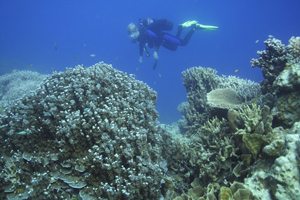
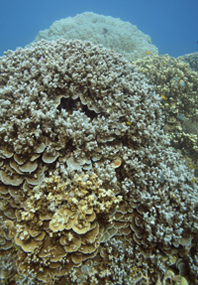
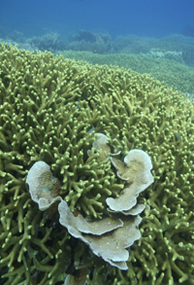

dense scleractinian coral coverage on the reef fringing
the east side of Penjalin Besar
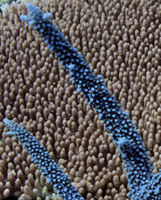
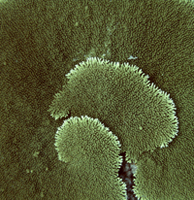
high diversity of Acropora spp. in the shallows
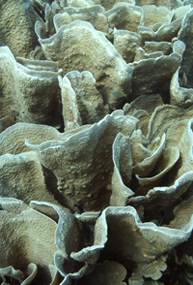
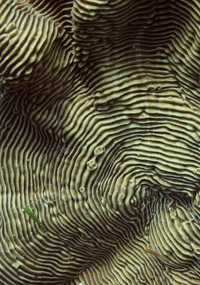
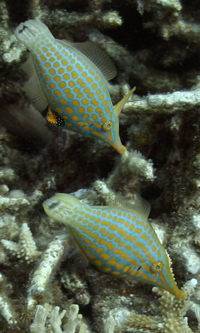
Echinopora lamellosa; Pachyseris speciosa; longnose filefish in the shallows
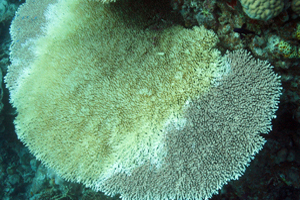

white band disease on a table Acropora colony; healthy
scleractinian coral
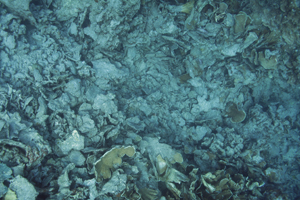
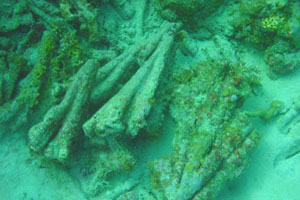
rubble from damaged plate corals;
damage from old dynamite blast shattering a colony
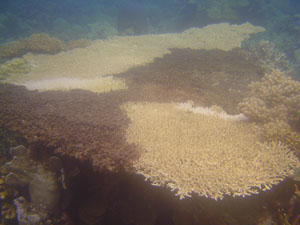
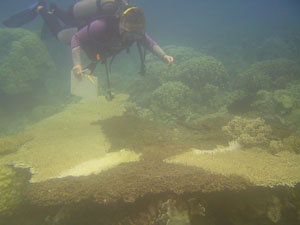
a large table Acropora colony
suffering from white band disease in the transect zone
Reef 2: fringing the west side of Penjalin
Kecil
Coral observations: Just off the SW
point of Penjalin Kecil there is a sand bottom which becomes increasingly populated
by coral bommies as you move NE towards the channel. Here there are large coral
colonies, especially massive Porites spp., foliaceous Montipora
spp. and Porites rus. We found one very large colony of foliaceous
Turbinaria spp., approximately 15 by 10 meters. This colony marked
the end of one section of the reef. We then passed over a 15 meter deep sand
channel with a single anemone in it. After a few minutes we came to another
section of the reef which had an extremely different population of hard corals
and 100% hard coral coverage as we moved further northwards along the reef;
massive Porites spp., extraordinary formations of Montipora
spp. with foliaceous layers surrounding the base of the colony, extending upwards
in fingers. Some of these Montipora spp. colonies were approximately
10 meters in diameter. Also some Diploastrea heliopora colonies in
very good health. Our dive here ended over a monospecific area of a branching
Acropora sp., approximately 50 by 50 meters.
Fish observations: About six small (approximately 20cm) Indonesian sweetlips (Diagramma melanacrum) were under a coral bommie. We found a school of rabbit and parrotfish, also drummers (Kyphosus spp.) in small groups, plus a few substantially sized harlequin sweetlips. However, it still felt like the fish observed were a mere fraction of the density of fish life that this substrate is able to support.
Invertebrate observations: There is a much higher coverage of soft corals on this side of the channel than on the west side, especially mushroom leather (Sarcophyton spp.) corals. There are many blue seastars (Linckia laevigata), a general observation on all reefs in the Anambas Islands, and many of the smaller species of giant clams, plus feather stars and sea fans. This would indicate that the current is more dynamic on this side of the channel.
Health and Vitality observations: One table Acropora spp. colony appeared to be suffering from white pox disease. There was an area with clusters of sea whips Junceella spp. One gorgonian sea fan was withering away. We made one observation of an unusual condition on a massive Porites sp. colony; a small area of white with an extremely bright white edge, approximately three corallites in width.
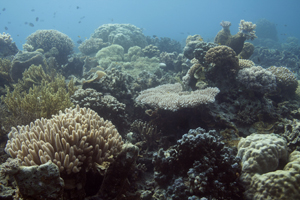
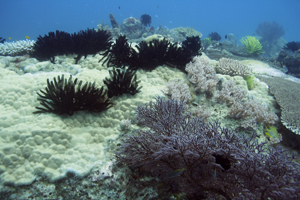
soft corals, feather stars and gorgonian sea fans at approximate
depths 10-20 meters
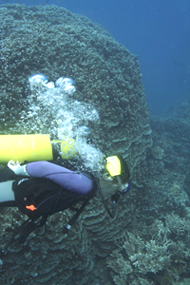
Reef 3: reef fringing rocks on west side of
Penjalin Besar
The reef here is shallow, about 5 meters maximum
depth. It extends away from the island and then drops off to about 40 meters
where it is mostly rubble. We snorkeled at this site.
Coral observations: The shallow reef is made up of patches of mostly massive Porites spp., Acropora spp., Astreopora spp., and Heliopora coerulea (blue coral). (Photo on the left: an enormous formation of Montipora spp. )
Fish observations: A single bonito leapt three times in front of the zodiac in a high arc as we were approaching the dive site. One blacktip reef shark was seen close to the dropoff. In the shallows one jack, orangespine unicorn fish, some rabbitfish, rudderfish and several sweetlips comprised the larger reef fish.
Health and vitality observations: Although there were several pretty scenes, the overall impression of this reef was that it is flawed. At least one colony in a cluster of about ten would be either diseased, ravaged by a crown of thorns or dead and covered in dark grey filamentous algae. Table Acropora spp. colonies were suffering from a curious condition in which part of the colony was bright white with the tissue removed, resembling extremely recent damage by a crown of thorns, but the rest of the colony was absolutely dead and overgrown with dark filamentous algae. It is possible that this particular algae is rampant and overgrows damaged patches of coral extremely quickly. One table Acropora spp. colony had a narrow white band in which the tissue and cilia were still visible. This band separated healthy coral tissues from dead tissue overgrown with dark grey filamentous algae. Another table Acropora spp. colony had lost its edges which had fallen to the ground in small pieces. The ‘new’ edge on the colony appeared to be wasting away rather than broken and the fragments on the seafloor were still alive and looked healthy. We sighted five crown of thorns here. A large Astreopora spp. colony had a very large section freshly killed by a crown of thorns. The seastar was anchored just beside the colony. We found a length of fishing line on the reef and a 5cm diameter length of cable.
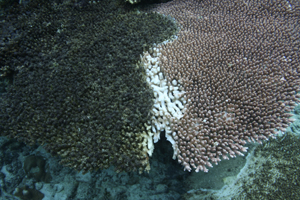
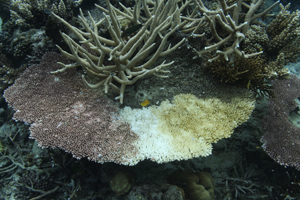
white band disease afflicting
many table Acropora colonies on this reef
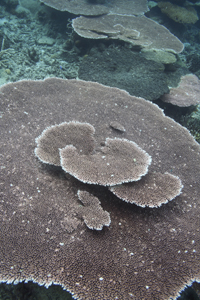
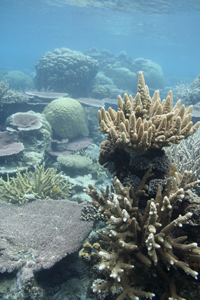
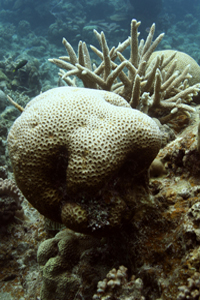
reef scenes on the west side of Penjalin Besar
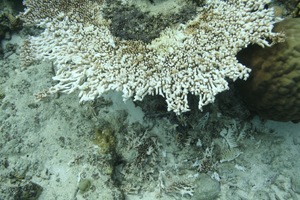
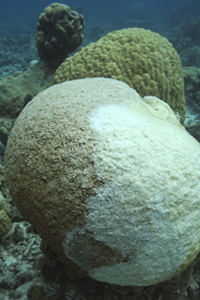
an Acropora colony;
a large Astreopora colony
with fresh tracks from a feeding crown of thorns seastar
Reef 4: reef fringing SW point
of Penjalin Besar
We took a very brief look at this area from the surface. The reef is
about 10-15 meters deep, comprising mostly table Acropora spp. colonies
interspersed with rock substrate.
Reef 5: reef patch SE corner of Penjalin Besar
On the SE corner of Penjalin Besar, there is a sand patch with some hard
coral coverage; large colonies of Goniopora spp., massive Porites
spp., Porites spp. fingers. Some colonies are broken, some have been
knocked over. This could be due to natural degradation or storm action. In places
this area is very shallow. The reef extends at least 50 feet.
page1 page 2 page 3 page 4 page 5 page 6 page 7 conclusion